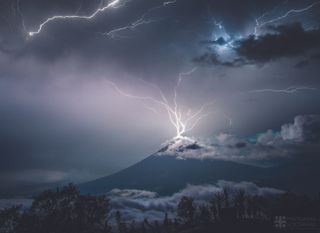'Volcano of Water' Turns into a Lightning Rod in This Electrifying Image
This image captures the moment the lightning hits the top of the crater.

A lightning storm over the famous Volcán de Agua (Volcano of Water) in Guatemala is captured in this electrifying image of the forested landmark.
The image, captured by astrophotographer Sergio Montúfar, shows lightning bolts shooting from two communication antennas near the top of the volcano's crater, creating an ominous effect in the night sky.
Although we tend to admire lightning as a powerful force of nature, exactly what causes lightning is still a mystery. The details of why lightning takes place are still being researched, NASA officials said in a description of the image.
Related: Earth Throws Stunning Light Show for Space Station Astronauts (Time-Lapse Video)
However, what we do know is that internal air currents cause collisions between icy particles within clouds, causing the electrical charges to separate between the top and the bottom of the clouds. As a result, NASA added, rapid electrical charges sprout out of the cloud and are known as lightning. Around 6,000 lightning bolts occur around the world every minute, according to NASA.
- Lightning Strikes Russian Docket During Satellite Launch
- Why Mars Lightning is Weak and Rare
- Raikoke Volcano's Eruption Seen from Space
Follow Passant Rabie on Twitter @passantrabie. Follow us on Twitter @Spacedotcom and on Facebook.
Get the Space.com Newsletter
Breaking space news, the latest updates on rocket launches, skywatching events and more!
Join our Space Forums to keep talking space on the latest missions, night sky and more! And if you have a news tip, correction or comment, let us know at: community@space.com.

Passant Rabie is an award-winning journalist from Cairo, Egypt. Rabie moved to New York to pursue a master's degree in science journalism at New York University. She developed a strong passion for all things space, and guiding readers through the mysteries of the local universe. Rabie covers ongoing missions to distant planets and beyond, and breaks down recent discoveries in the world of astrophysics and the latest in ongoing space news. Prior to moving to New York, she spent years writing for independent media outlets across the Middle East and aims to produce accurate coverage of science stories within a regional context.
